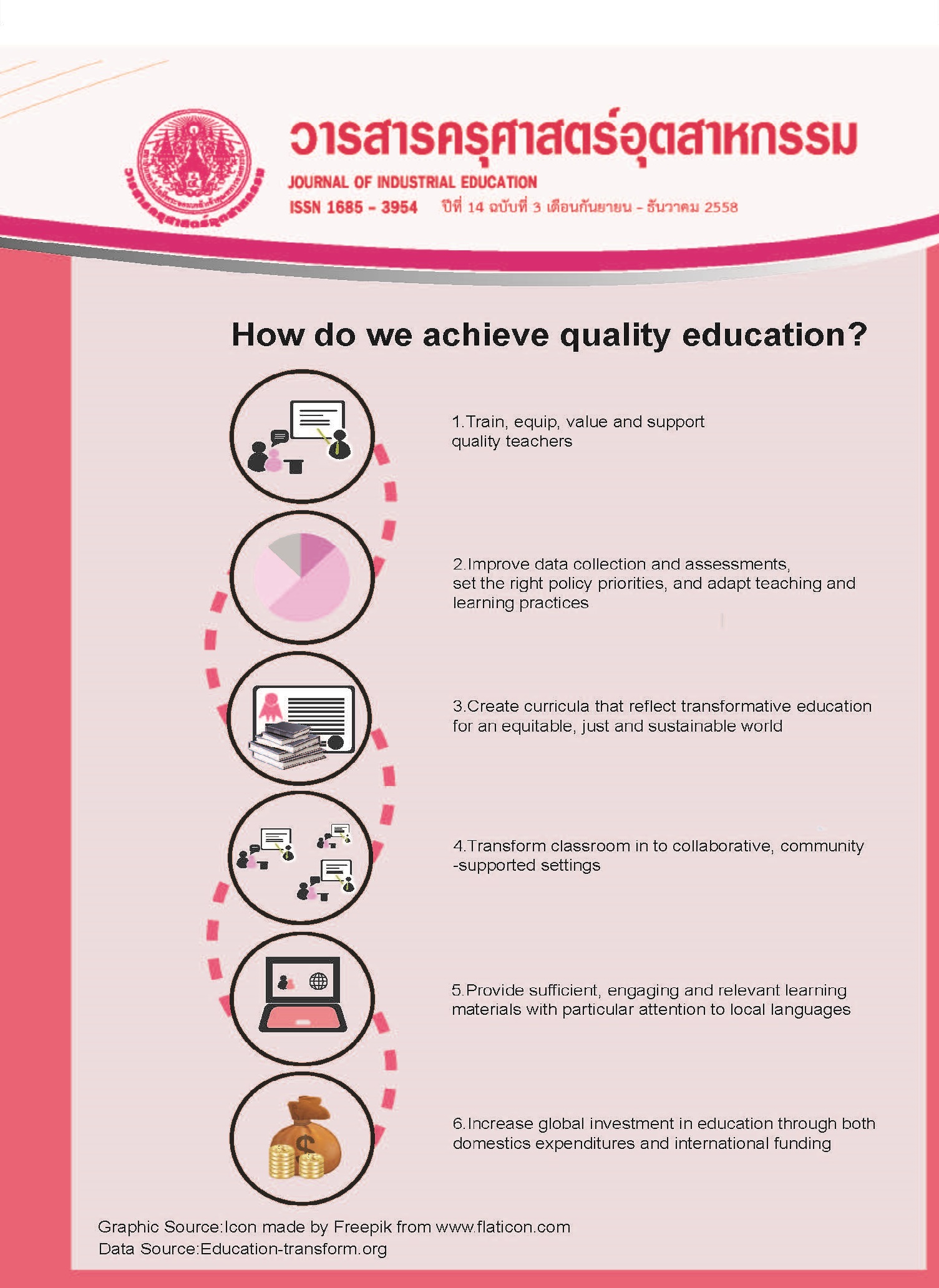The development of web-based instruction with constructivist theory on funcion
Main Article Content
Abstract
The objectives of this study were (1) to develop and examine the efficiency of web-based instruction (WBI) with Constructivist Theory on Function and (2) to compare the learning achievement between students learning with the web-based instruction with Constructivist Theory on Function and the students learning with conventional instruction. The sample of the study comprised of 72 students(Grade 10) from a total of 3 classrooms who enrolled Advance Programming course at Princess Chulabhorn’ College Pathumthani in the academic year2/2014, selected by Cluster Random Sampling method. The research instruments were a web based instruction with Constructivist Theory on Function and a 25-item achievement test with Index of Item-Objective Congruence (IOC) of achievement test was between 0.80-1.00. The difficulty was between 0.29– 0.79, and discrimination was 0.25-0.58. The reliability was 0.91. Data statistics using average, standard deviation and t-test Independent.
The result presented that (1) the quality level in web-based instruction with Constructivist Theory on Function in tern average of content is very good ( = 4.71, S.D. = 0.38) and the average production technique is very good (
= 4.61, S.D. = 0.45), and web-based instruction on Function had the efficiency equal to 80.83 : 81.67 (2) The students who learned with the web based instruction with Constructivist Theory showed significantly higher learning achievement than the students who learned with the conventional instruction (
= 20.04 and 18.17, respectively) at .05 levels.
Article Details
"The opinions and contents including the words in papers are responsibility by the authors."
"ข้อคิดเห็น เนื้อหา รวมทั้งการใช้ภาษาในบทความถือเป็นความรับผิดชอบของผู้เขียน"
References
[2] กิดานันท์ มะลิทอง. 2540. เทคโนโลยีและนวัตกรรมการศึกษา. กรุงเทพฯ: จุฬาลงกรณ์มหาวิทยาลัย.
[3] ถนอมพร เลาหจรัสแสง. การสอนบนเว็บ(Web-Based Instruction) นวัตกรรมเพื่อคุณภาพการเรียนการสอน. วารสารศึกษาศาสตร์ มหาวิทยาลัยเชียงใหม่, 1(28), น. 87-94.
[4] บุปผชาติ ทัฬหิกรณ์. 2544. ความรู้เกี่ยวกับสื่อมัลติมีเดียเพื่อการศึกษา: หนังสือเสริมประสบการณ์ระดับประถมศึกษาและระดับมัธยมศึกษา. กรุงเทพฯ: ศูนย์พัฒนาหนังสือกรมวิชาการ.
[5] ณัฐกร สงคราม. 2553. การออกแบบและพัฒนามัลติมีเดียเพื่อการเรียนรู้. กรุงเทพฯ: สำนักพิมพ์แห่งจุฬาลงกรณ์มหาวิทยาลัย.
[6] Hannafin, Susan, Kevin. 1999. Open Learning Environments: Foundations, Methods and Models In Charles M. Reigluth (ED), Instructional Design Theories And Models: A New Paradigm of Instructional Theory. Volume II New jersey: Lawrence Erlbaum Associates.
[7] Jonassen D. H. et al. 2003. Learning to Solve Problems with Technology; A Constructivist Perspective. 2nd ed. Ohio: Merrill Prentice Hall.
[8] Cunningham, D. J., & Knuth, r. 1993. Tools for constructivism, In T. Duffy, J. Lowyck & D.
[9] ประวิทย์ สิมมาทัน. 2552. การพัฒนารูปแบบการเรียนการสอนแบบร่วมมือบนเครือข่ายคอมพิวเตอร์ สำหรับนักศึกษาระดับปริญญาตรีโดยอาศัยแนวทฤษฎีคอนสตรัคติวิสต์. บัณฑิตวิทยาลัย มหาวิทยาลัยเทคโนโลยีพระจอมเกล้าพระนครเหนือ
[10] ชัยยงค์ พรหมวงศ์ และคณะ. 2521. ระบบสื่อการสอน. กรุงเทพฯ: สำนักพิมพ์จุฬาลงกรณ์มหาวิทยาลัย.
[11] Anderson, L.W, and Krathwohl, D.R. 2001. A Taxonomy for Learning, Teaching, and Assessing: A Revision of Bloom's Taxonomy of Educational Objectives. New York: Longman.
[12] ณัฐพล ธนเชวงสกุล. 2555. การพัฒนาบทเรียนอิเล็กทรอนิกส์ เรื่องวัฏจักรทางเทคโนโลยี. วารสารครุศาสตร์อุตสาหกรรม, 3(11), น.45-53.
[13] ณัฐกร สงคราม. 2552. การพัฒนาบทเรียนคอมพิวเตอร์ช่วยสอนเพื่อการแก้ปัญหาทางการถ่ายภาพ สำหรับนักศึกษาระดับปริญญาตรี. ค้นเมื่อวันที่ 13 เมษายน 2558, จาก https://www.kmitl.ac.th/agritech/nutthakorn/article/phootcai.pdf
[14] พรรณรวี สงวนพงษ์. 2555. การพัฒนาบทเรียนผ่านเครือข่ายอินเทอร์เน็ต เพื่อการทบทวน เรื่อง ความรู้เบื้องต้นของหลักการเขียนโปรแกรม สำหรับนักเรียนระดับประกาศนียบัตรวิชาชีพ. วารสารครุศาสตร์อุตสาหกรรม, 2(11), น.55–63.

